Publication or use of pictures, recipes, articles, or any other material form my Web site, on or off-line without written permission from the author is prohibited. If you would like to use my articles on your Web site or in your publication, contact me for details. Avoid infringing copyright law and its consequences: read the article 7 Online Copyright Myths by Judith Kallos
Read our
DISCLAIMER and
PRIVACY POLICY
before using
our site
-------------------
Linking Policy
Advertise with us
DISCLAIMER and
PRIVACY POLICY
before using
our site
-
Advertise with us
Copyright © 2003 - 2011 Anna Maria Volpi - All Rights reserved.
Anna Maria's Open Kitchen Site Map
site map
recipes
policies
about us
Some More Hot Topics You'd Like to See adv.



Printer
Friendly
Recipe




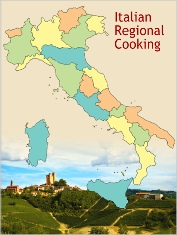

Anna Maria Suggests
Extra-
The Best Selection of Italian Extra-
Buy from the source Authentic Aged Traditional Balsamic Vinegar from Italy
Sicily, Apulia, Lazio, Liguria, and More...The Best Selection of Succulent Italian Olives Oil
Infused Extra-
Spice up your dishes with Infused Flavored Italian Extra-





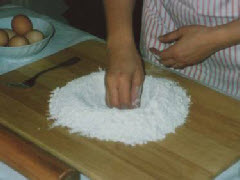
Making fresh pasta dough
Making homemade pasta takes time and effort, but there is something special about making pasta from scratch.
Making pasta at home is rewarding and EASY, and you can make exactly the shape you like, or add the special flavor and color you want.
You can use machines to help you obtain the best result in the minimal time. There is no comparison between the boxed noodle and the fresh pasta you knead yourself: delicate texture, soft consistency, tastes delicious, costs pennies. Follow the easy step-by-step instruction and you cannot fail!
Flour: (15 oz, approximately 400 gr). Use normal unbleached all-purpose flour. Other flours can eventually be used in place of, or in addition to the base flour. Semolina or bran would add more texture to the dough, but make it harder.
Eggs: Use only very fresh, large eggs. Most of the industrially produced eggs are very light in color and have light taste. Buy eggs that are specifically indicated as having “golden” yolk, from farm-bred chicken.
Extra-virgin olive oil: This gives more smoothness to the dough and makes it easier to knead.
optional ingredients
Salt. It is optional, and most pasta makers add salt only to the condiments.
Flavoring ingredients. Additional taste can be given by adding to the dough parmigiano cheese, wine, or spices.
Coloring ingredients. For different coloring use only natural ingredients, such as the saffron for intense yellow, red beet for violet, tomato paste for red, spinach for green, bitter chocolate for dark brown, and squid ink for black. Quantity of egg should be reduced proportionally when adding coloring ingredients.
equipment
Cutting board. Use a wooden board that should be approximately 2 feet wide x 3 feet long (60 x 90 cm), made out of compact hardwood that doesn’t chip when hit by the knife. The long edge should have on the bottom an additional wooden trim. This prevents the board from sliding while you knead the dough.
Rolling pin. This should be one solid perfect wooden cylinder with rounded edges, about 3 feet long (90 cm) x 2 inches in diameter (5 cm).
Knife. Use a sharp cook’s knife.
Spatula. You need a large square spatula to clean the board from pasta residues.
Making homemade pasta takes time and effort, but there is something special about making pasta from scratch.
Making pasta at home is rewarding and EASY, and you can make exactly the shape you like, or add the special flavor and color you want.
You can use machines to help you obtain the best result in the minimal time. There is no comparison between the boxed noodle and the fresh pasta you knead yourself: delicate texture, soft consistency, tastes delicious, costs pennies. Follow the easy step-
Flour: (15 oz, approximately 400 gr). Use normal unbleached all-
optional ingredients
Salt. It is optional, and most pasta makers add salt only to the condiments.
Flavoring ingredients. Additional taste can be given by adding to the dough parmigiano cheese, wine, or spices.
Coloring ingredients. For different coloring use only natural ingredients, such as the saffron for intense yellow, red beet for violet, tomato paste for red, spinach for green, bitter chocolate for dark brown, and squid ink for black. Quantity of egg should be reduced proportionally when adding coloring ingredients.
equipment
Cutting board. Use a wooden board that should be approximately 2 feet wide x 3 feet long (60 x 90 cm), made out of compact hardwood that doesn’t chip when hit by the knife. The long edge should have on the bottom an additional wooden trim. This prevents the board from sliding while you knead the dough.
Rolling pin. This should be one solid perfect wooden cylinder with rounded edges, about 3 feet long (90 cm) x 2 inches in diameter (5 cm).
Knife. Use a sharp cook’s knife.
Spatula. You need a large square spatula to clean the board from pasta residues.
Sift the flour. Pour it on the wooden board. Shape it into a mound, and hollow the center.
Break the eggs and pour them in the hollow.
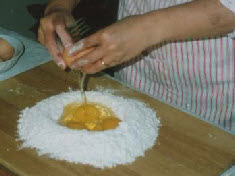
Using a fork, beat the eggs together. Gently bring some of the flour into the egg mix.
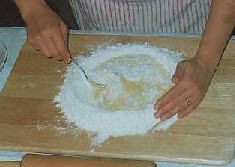

Continue drawing flour into the eggs a little at a the time until all the flour is absorbed.
Use your hands to obtain a uniform mixture.
After cleaning the pasta residues off the work surface, pour a thin layer of flour to prevent the fresh pasta from sticking on it.
Return the dough to the work surface . . . .

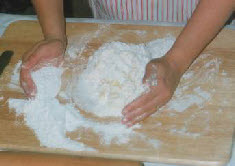

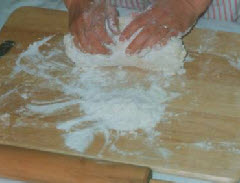
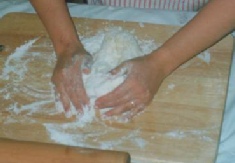
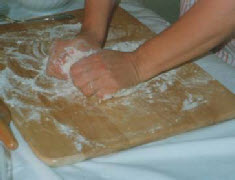
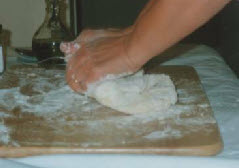
. . . . and knead the pasta, pushing with the palm of your hands.
Alternatively push . . . .
Make a round, smooth ball and place it on a plate.
Cover with a moistened cloth or a plastic wrap, and let the dough rest for 30 minutes to 1 hour.
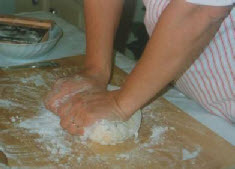
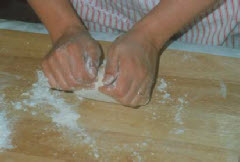
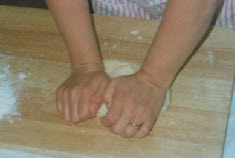


. . . . and fold the dough.
Repeat this step of pushing . . . .
. . . . for 8 to 10 minutes, or until the dough feels smooth and firm.
. . . . and folding . . . .


How to Make Fresh Pasta
(1) How to Make Fresh Pasta Dough
(1) How to Make Fresh Pasta Dough
Basics >> Preparing Fresh Pasta Dough

How to Make Fresh Pasta

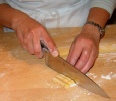


*****
1/2 hour
Serves 4
First Course
-